芦他卡品通过靶向 CK2α 减轻糖尿病肾病的炎症和纤维化
IF 6.9
2区 医学
Q1 MEDICINE, RESEARCH & EXPERIMENTAL
引用次数: 0
摘要
糖尿病肾病(DN)是糖尿病严重的微血管并发症之一。在糖尿病肾病的发展过程中,肾小球系膜细胞(GMCs)的增殖导致过多的细胞外基质(ECM)在系膜区域沉积,最终导致肾小球硬化。芦根碱(Rut)是一种生物碱,存在于传统中药材枸杞子(Euodia rutaecarpa (Juss.) Benth.)中,具有多种生物活性。然而,它在 DN 中的作用机制仍然未知。本研究使用 db/db 小鼠和高糖(HG)处理的小鼠间质细胞(SV40 MES-13)来评估芦根对 DN 中 GMC 的保护作用及其潜在机制。我们发现,路得能减轻尿白蛋白和肾功能,明显缓解肾脏病理损伤。此外,路得还能减少 ECM 的产生和肾脏炎症,并抑制 TGF-β1/Smad3 和 NF-κB 信号通路在体外和体内的激活。通过靶点预测、分子对接、细胞热转移试验(CETSA)和表面等离子体共振(SPR),蛋白激酶CK2α(CK2α)被确定为Rut的靶点。此外,沉默 CK2α 后,Rut 无法继续在经 HG 处理的 SV40 细胞中发挥保护作用。综上所述,本研究首次发现 Rut 可通过抑制 TGF-β1/Smad3 和 NF-κB 信号通路的激活以及靶向 CK2α 来抑制经 HG 处理的 SV40 细胞中 ECM 的生成和炎症反应。因此,Rut 有可能成为一种治疗 DN 的新方法。本文章由计算机程序翻译,如有差异,请以英文原文为准。
Rutaecarpine alleviates inflammation and fibrosis by targeting CK2α in diabetic nephropathy
Diabetic nephropathy (DN) is one of the serious microvascular complications of diabetes mellitus. During the progression of DN, the proliferation of glomerular mesangial cells (GMCs) leads to the deposition of excessive extracellular matrix (ECM) in the mesangial region, eventually resulting in glomerulosclerosis. Rutaecarpine (Rut), an alkaloid found in the traditional Chinese medicinal herb Fructus Evodiae (Euodia rutaecarpa (Juss.) Benth.), has many biological activities. However, its mechanism of action in DN remains unknown. This study used db/db mice and high glucose (HG)-treated mouse mesangial cells (SV40 MES-13) to evaluate the protective effects of Rut and underlying mechanisms on GMCs in DN. We found that Rut alleviated urinary albumin and renal function and significantly relieved renal pathological damage. In addition, Rut decreased the ECM production, and renal inflammation and suppressed the activation of TGF-β1/Smad3 and NF-κB signaling pathways in vitro and in vivo. Protein kinase CK2α (CK2α) was identified as the target of Rut by target prediction, molecular docking, and cellular thermal shift assay (CETSA), and surface plasmon resonance (SPR). Furthermore, Rut could not continue to play a protective role in HG-treated SV40 cells after silencing CK2α. In summary, this study is the first to find that Rut can suppress ECM production and inflammation in HG-treated SV40 cells by inhibiting the activation of TGF-β1/Smad3 and NF-κB signaling pathways and targeting CK2α. Thus, Rut can potentially become a novel treatment option for DN.
求助全文
通过发布文献求助,成功后即可免费获取论文全文。
去求助
来源期刊
CiteScore
11.90
自引率
2.70%
发文量
1621
审稿时长
48 days
期刊介绍:
Biomedicine & Pharmacotherapy stands as a multidisciplinary journal, presenting a spectrum of original research reports, reviews, and communications in the realms of clinical and basic medicine, as well as pharmacology. The journal spans various fields, including Cancer, Nutriceutics, Neurodegenerative, Cardiac, and Infectious Diseases.

 求助内容:
求助内容: 应助结果提醒方式:
应助结果提醒方式:


